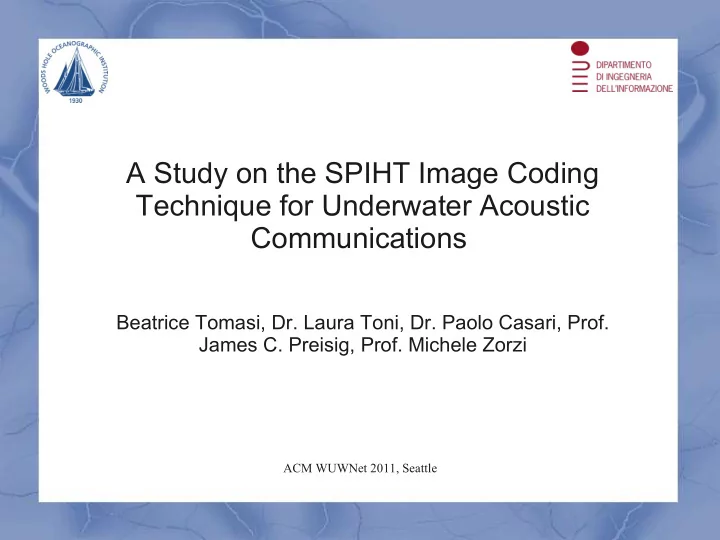

A Study on the SPIHT Image Coding Technique for Underwater Acoustic Communications Beatrice Tomasi, Dr. Laura Toni, Dr. Paolo Casari, Prof. James C. Preisig, Prof. Michele Zorzi ACM WUWNet 2011, Seattle
Objectives and motivations ● Applications for underwater image transmissions: – Discovery of new species in marine biology – Ecology – Meteorology – Oceanography – Oil spill relief operations – Detection of underwater mines ACM WUWNet 2011, Seattle
Objectives and motivations ● Study and comparison of two FEC allocation schemes for progressive source coding: Basic and Multi Description (MD)-like allocations ● Results in terms of Peak Signal to Noise Ratio vs SNR ● Assessment of the suitability of these schemes for the underwater scenario by validation on SPACE08 ACM WUWNet 2011, Seattle
Progressive Source Coding ● Quality of decoded information proportional to amount of received information ● Decoding process stops whenever a bit budget or a distortion objective is met ● Capability of managing redundancy conveniently by adapting to channel conditions ACM WUWNet 2011, Seattle
Basic Allocation Each pkt is protected in time with a Reed-Solomon and CRC ● channel coding c j c j 1 Sequential FEC allocation: ● Unequal Error Protection (UEP) the more important bits, the ● higher protection Packets have the same length ● Assumption of erasure channel: if CRC fails then the packet is ● dropped ACM WUWNet 2011, Seattle
Basic Allocation ● Optimization of the FEC allocation by N t r =[ r 1 ,r 2 , ... ,r N t ]= argmin ∑ D R j r P j r D 0 P 0 j ● Subjected to a constraint on the overall bit budget N t ∑ c j / r j B tot j = 1 r j ● , code rate for pkt j c j ● , number of source information bits D . ● , rate-distortion curve R j ● , received information bit budget ACM WUWNet 2011, Seattle
MD-like allocation N t Information bits spread across pkts ● Allocation and vertical channel coding with maximum distance ● N t , k l f l = N t − k l RS codes. If codeword, is the amount of FEC Progressive nature of the encoder is in the vertical allocation ● f l f l 1 UEP Packets have the same importance, Equal Error Protection in ● the horizontal FEC allocation ACM WUWNet 2011, Seattle
MD-like allocation ● The quality of the received image depends on how many and not which packets have been received pmf of P N t g the number (g) of lost packets ● The total bit budget when the j-th packet is received R j = ∑ c l × B RS l : c l j ● Optimized allocation of the horizontal EEP and vertical UEP: L RS [ r , f 1 , f 2 , ... , f L RS ]= argmin ∑ D R l r , f l P N t N t − l D 0 P N t 0 l = 1 ACM WUWNet 2011, Seattle
SPACE08 data set TX: Source, central frequency fc = 11.5 kHz, B = 8 kHz RX: S5@1000. Where: Near Martha’s Vineyard island operated WHOI. When: 18-27 October 2008, corresponding to Julian dates 292-301. Why: channel exhibits time varying behavior due to the environmental changes and different environmental conditions were observed and measured. Tx S4 S3 S6 S5 ACM WUWNet 2011, Seattle
SPACE08 data set Multiple repetitions of a 4095 point binary maximum length sequence Channel impulse response estimated over segments of 400 symbols (60 ms). After each estimation we shift the window by 100 symbols (15 ms), resulting in an estimate every 15 ms over windows of 60 ms R= 6.5 kbps, symbol rate Fc: 11.5 kHz, Central frequency A transmission three minutes in duration was made once every two hours ACM WUWNet 2011, Seattle
Simulative study: system model r n a n encoder Mod ch dec + noise From data set ● Rescale the noise performance at different SNRs ● Compression rate 0.3 ● 512x512 bit ● Nt = 153, number of total pkts per image ● Coding rates = {0.7, 0.8, 0.9} ACM WUWNet 2011, Seattle
Results ● “shadowing” the transmitter knows only the average SNR per image ● “ideal”, genie-aided system, the TX knows the instantaneous SNR This comparison highlights the importance of instantaneous CSI for each image ● “analytical” study, we estimated the PER from the data and we assume iid error among the packets ● “simulation” study, we use the channel realizations This comparison validates the iid model for packet errors ACM WUWNet 2011, Seattle
Results: FEC Allocation for S3 ● Trade-off between the transmission information rate and reliability ACM WUWNet 2011, Seattle
Results: PSNR vs SNR Def: ● 2 / E D PSNR = 10log 255 MD-like provides the ● best tradeoff between reliability and transmission rate MD outperforms Basic ● in the low-middle SNR regime Basic requires an ● instantaneous CSI in theory, but from simulations the average SNR per image is a ACM WUWNet 2011, Seattle sufficient information
Results: image quality Basic Allocation Basic Allocation 12 dB 6 dB MD-like Allocation ACM WUWNet 2011, Seattle
Conclusions ● Quantitative study of two FEC allocation schemes for image progressive source coding ● Performance comparison in terms of PSNR vs SNR ● Results show that MD-like allocation outperforms Basic allocation, especially in low SNR, and is more robust to the varying channel conditions at the cost of a slightly larger storage capability @ rx ACM WUWNet 2011, Seattle
Conclusions ● Try this allocation technique during future experiments ● The results have been computed by using a data set, which includes different environmental conditions, so as to show the suitability of such techniques at different environmental conditions ● Further investigations on the role of the time varying second order statistics should be done in the future ACM WUWNet 2011, Seattle
Recommend
More recommend